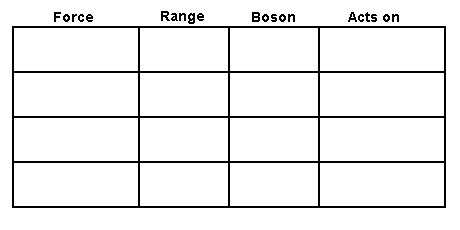
The Standard Model is the theory of fundamental particles and their interactions. It is widely tested and is accepted as correct by particle physicists. The following activities serve as an introduction to this theory.
A. Introductory Reading: The science of matter, space and time
1. Are atoms the smallest units of matter? If not, what are the fundamental building blocks?
2. Why isn't empty space really empty?
3. What might be a reason why our universe consists mostly of matter and not antimatter?
4. About how much of the universe consists of matter we can see? What question does this bring up for astrophysicists?
B. Introductory Activity: Open the Atom Builder and construct a carbon atom.
1. What particles make up a proton?
2. What particles make up a neutron?
3. What particles make up an electron?
4. What makes an atom unstable?
5. What makes an atom ionized?
6. What makes an atom radioactive?
7. When does an atom change into another element?
C. Using these references, answer the following questions:
What is the world made of?
A Summary of Particle Physics
1. How many building blocks have been identified that are the fundamental constituents of matter?
2. Fill in the symbols and names of the particles in the Standard Model chart below. You can find a bigger chart here to use as a reference.

3. How many fundamental particles make up the matter of our everyday world and what are they? Why isn't this matter made up of the other particles?
4. What is antimatter? What happens when antimatter meets matter?
5. If a proton consists of uud quarks, what would an antiproton consist of? What would be the charge of an antiproton?
6. What is another name for an antielectron? What charge does it have?
7. Can quarks be found by themselves? Can leptons?
8. Play Level 4 of Particle families. From this game and the readings, summarize the characteristics of the following families of hadrons (composite particles consisting of quarks)
a) baryons
b) mesons
9. Play Four Forces. Fill in the chart below for the four elementary forces from strongest to weakest (a boson is a force-carrying particle).

a. atoms combining to form crystals and molecules
b. the moon orbiting the earth
c. beta decay (neutron decaying into a proton)
d. binding electrons to atomic nuclei
e. a quark changing into another kind of quark (or a lepton into another kind of lepton)
f. the binding of protons and neutrons in the nucleus
g. friction
h. our weight on earth
i. the gluing together of quarks to form hadrons
j. nuclear fission producing alpha particles